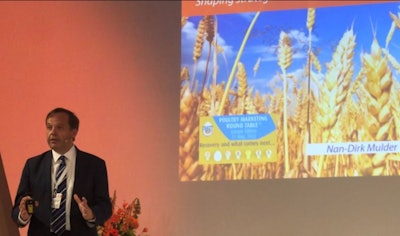
For several years, the European poultry and egg industries have had to contend with many challenges – a trend that seems unlikely to let up in 2022. Rabobank senior animal protein analyst Nan-Dirk Mulder cites the war in Ukraine, input cost inflation and avian influenza (AI) among the main market drivers shaping production this year.
“If you look back, in the last three years, we have seen incredible volatility in animal protein markets – and if you’re a producer of eggs and chicken, this is an incredibly challenging landscape,” Mulder said at the Poultry Marketing Round Table, organized by WATT Global Media, MEAP and VIV, and co-located with VIV Europe.
According to his presentation, feed prices have increased by 45% year-over-year with a Ukraine-related rally. In addition, COVID-19-related demand shifts away from food service toward retail saw poultry meat and egg demand grow between 10% to 50%.
“If you were a producer and selling into retail, it was pretty good but very volatile,” he said. “On the other end, avian influenza is making a big impact with cases on the rise. From a strategic perspective, it’s been quite a lot for producers in both the poultry and egg industry.”
Poultry, egg sector passing feed prices on to consumer
Global export shares of key agricultural commodities coming out of Ukraine, Russia and Belarus have been the most directly affected by the war in Ukraine. Mulder suggests wheat, corn, sunflower and fertilizers are the commodities to watch, as Ukraine is the main exporter of these commodities to Europe and Saudi Arabia.
“We see differences between producers, and it depends also on contract positions in the value chain. Some have a long-term contract, and therefore it takes a while before you get that benefit. It depends on how you are positioned in the industry. But in general, if you look back, I think both the poultry and egg sectors have more or less been able to deal with it, although there are differences.”
AI, high feed costs and the aftermath of COVID-19 have kept eggs and chicken meat supplies tight, but producers are also challenges trying to pass it along to the consumer. European chicken breast prices have risen more than 35% in 2022 and egg prices by more than 50%, Rabobank reports.
“If you look at 2022, I would say it's going to be a challenging year for the industry,” Mulder said. “If you look to the market side, the market is going to be more price focused. The biggest challenges are going to be on the input side -- feed prices are going to stay high, labor costs and energy costs will remain high -- so I think all these issues are really a headache for producers in this situation.”
Positive long-term outlook for chicken, eggs
The good news? Looking at the EU-27, poultry and eggs are the winners in the animal protein space.
“We expect 1 million tons more demand for poultry between 2021 and 2027,” Mulder said. “The industry is already growing at 1.1% per year. Egg consumption will grow by 350,000. Both sectors will be the next leading proteins and it's because the price position is essential.”
A Rabobank analysis predicts beef will decrease by 300,000 tons and pork by 800,000 during the same period.
To achieve these gains, Mulder also stresses the importance of embracing and communicating for the industry, and the individual, on sustainability and welfare efforts within the poultry and egg sectors because social concerns regarding production – slow-growing, cage-free, and male chick culling – will continue to weigh heavily on consumer behavior.
“The challenge for producers, in my view, is to balance on one side, fine-tuning your business, your product, your performance, your product supply, with a proactive, open take toward society and being part of the social discussion to show what you're doing [in regard to sustainability],” he said. “And that is, I think the most important thing to keep your license to operate as an industry.”















